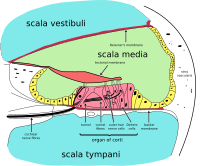
Photo from wikipedia
Genome-wide association studies (GWAS) provide an unbiased first look at genetic loci involved in aging and noise-induced sensorineural hearing loss and tinnitus. The hearing phenotype, whether audiogram-based or self-report, is… Click to show full abstract
Genome-wide association studies (GWAS) provide an unbiased first look at genetic loci involved in aging and noise-induced sensorineural hearing loss and tinnitus. The hearing phenotype, whether audiogram-based or self-report, is regressed against genotyped information at representative single nucleotide polymorphisms (SNPs) across the genome. Findings include the fact that both hearing loss and tinnitus are polygenic disorders, with up to thousands of genes, each of effect size of < 0.02. Smaller human GWAS' were able to use objective measures and identified a few loci; however, hundreds of thousands of participants have been required for the statistical power to identify significant variants, and GWAS is unable to assess rare variants with mean allele frequency < 1%. Animal studies are required as well because of inability to access the human cochlea. Mouse GWAS builds on linkage techniques and the known phenotypic differences in auditory function between inbred strains. With the advantage that the laboratory environment can be controlled for noise and aging, the Hybrid Mouse Diversity Panel (HDMP) combines 100 strains sequenced at high resolution. Lift-over regions between mice and humans have identified over 17,000 homologous genes. Since most significant SNPs are either intergenic or in introns, and binding sites between species are poorly preserved between species, expression quantitative trait locus information is required to bring humans and mice into agreement. Transcriptome-wide analysis studies (TWAS) can prioritize putative causal genes and tissues. Diverse species, each making a distinct contribution, carry a synergistic advantage in the quest for treatment and ultimate cure of sensorineural hearing difficulties.
Journal Title: Human genetics
Year Published: 2021
Link to full text (if available)
Share on Social Media: Sign Up to like & get
recommendations!